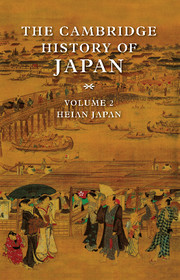Book contents
- Frontmatter
- Introduction
- 1 The Heian court, 794–1070
- 2 The capital and its society
- 3 Land and society
- 4 Provincial administration and land tenure in early Heian
- 5 Chinese learning and intellectual life
- 6 Aristocratic culture
- 7 Aristocratic Buddhism
- 8 Religious practices
- 9 Insei
- 10 The rise of the warriors
- Works cited
- Glossary-index
- Japan in the Heian period"
- References
8 - Religious practices
Published online by Cambridge University Press: 28 March 2008
- Frontmatter
- Introduction
- 1 The Heian court, 794–1070
- 2 The capital and its society
- 3 Land and society
- 4 Provincial administration and land tenure in early Heian
- 5 Chinese learning and intellectual life
- 6 Aristocratic culture
- 7 Aristocratic Buddhism
- 8 Religious practices
- 9 Insei
- 10 The rise of the warriors
- Works cited
- Glossary-index
- Japan in the Heian period"
- References
Summary
Upon arising, first of all repeat seven times in a low voice the name of the star of the year. Take up a mirror and look at your face, to scrutinize changes in your appearance. Then look at the calendar and see whether the day is one of good or evil omen. Next use your toothbrush and then, facing West, wash your hands. Chant the name of the Buddha and invoke those gods and divinities whom we ought always to revere and worship. Next make a record of the events of the previous day. Now break your fast with rice gruel. Comb your hair once every three days, not every day. Cut your fingernails on a day of the Ox, your toenails on a day of the Tiger. If the day is auspicious, now bathe, but only once every fifth day.
As these Testamentary Admonitions of Fujiwara no Morosuke (908–60) indicate, the life of aristocrats during the Heian period was punctuated by a plethora of practices and precautions of a ritual character. What appear on the surface to be common practices, such as washing one's hands or brushing one's teeth, were directly related to the daily performance of specific rites dedicated to various kami and buddhas and bodhisattvas. These rites were related to Taoist practices, to various ritual elements of Buddhism, or to beliefs and practices subsumed under the category of yin and yang. Yet other ritual practices were of a political character, or appear to be outside any immediately identifiable framework. This complexity of the ritual and liturgical world was part and parcel of life among aristocrats during the Heian period.
- Type
- Chapter
- Information
- The Cambridge History of Japan , pp. 517 - 575Publisher: Cambridge University PressPrint publication year: 1999
References
- 7
- Cited by

